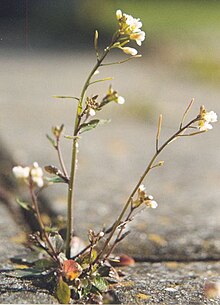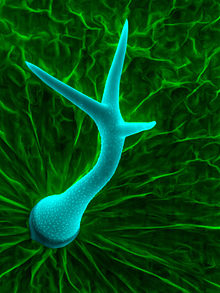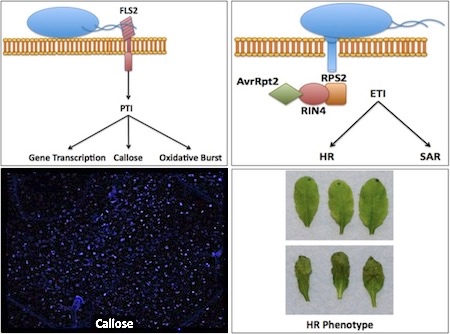산장대(3)
https://daehyo49.tistory.com/7816102
산장대(2)
https://daehyo49.tistory.com/7812123
산장대(1)
https://daehyo49.tistory.com/7808577
바위장대
https://daehyo49.tistory.com/7811968
애기장대
https://daehyo49.tistory.com/7810357
Arabis 종 검색표(한국속식물지)
https://daehyo49.tistory.com/7809855
학명: Arabidopsis thaliana (L.) Heynh.
분류: 십자화과 (Cruciferae)
학명 풀이:
Arabidopsis: resembling Arabis(장대속)
thaliana: 독일인 의사이자 식물학자 Johannes Thal (1542-1583)
영명: thale cress, mouse-ear cress
일어명:シロイヌナズナ
사진: 2014.04.30 탄천
아래는 잎의 털 확대 사진
털 끝이 2갈래로 갈라진다
아래: 2021.03.24 탄천



열매는 장각과

꽃받침잎은 뒷면에 털이 있다


근생엽은 도피침형이고 총생하여 옆으로 퍼진다. 줄기는 하부에서는 퍼진털이 밀생화고 상부는 거의 무모이다

경생엽은 드문드문 있다

잎의 털은 2갈래로 갈라진 털이다
애기장대(좌)와 냉이(우) 비교

아래 : 2024.04.05 일산 호수공원



아래쪽에 냉이가 함께 있다





<국가생물종지식정보시스템> 설명
잎
근생엽은 도피침형이고 총생하여 옆으로 퍼지고 길이 2~4cm, 폭 3-15mm로서 가장자리에 희미한 톱니가 있고 양면에 2개로 갈라진 털이 있으며 경생엽은 도피침형 또는 선형이고 드문드문 달리며 가장자리는 밋밋하다.
열매
열매는 장각과로서 비스듬히 퍼지거나 곧추서며 길이 15-20mm, 지름 0.5mm이고 소화경은 열매일 때는 길이 6-8mm이다. 종자는 타원형이며 길이 0.5mm이고 가장자리가 둔하다.
꽃
꽃은 4~5월에 피며 백색의 십자화이고 총상화서는 가지 끝과 원줄기 끝에서 서며 꽃받침잎은 타원형이고 길이 2mm로서 뒷면에 털이 있으며 꽃잎은 도피침형이고 길이 3-3.5mm이다.
줄기
높이 15-35cm이고 가지가 갈라지며 곧게 서고 털이 없다.
원산지
한국
분포
경기도 이남에서 자란다.
형태
2년생 초본
크기
높이 15~35cm
생육 환경
들판, 산기슭이나 바닷가의 풀밭에 자란다.
특징
전체에 털이 거의 없다.
설명. 1:
FOC
Arabidopsis thaliana (Linnaeus) Heynhold in Holl & Heynhold, Fl. Sachsen. 1: 538. 1842.
鼠耳芥 shu er jie
(학명 이명)
Arabis thaliana Linnaeus, Sp. Pl. 2: 665. 1753; Sisymbrium thalianum (Linnaeus) J. Gay & Monnard; Stenophragma thalianum (Linnaeus) Celakovsky.
(설명)
Herbs annual, (2-)5-30(-50) cm tall. Stems erect, 1 or few from base, simple or branched above, basally with predominantly simple trichomes, apically glabrous. Basal leaves shortly petiolate; leaf blade obovate, spatulate, ovate, or elliptic, 0.8-3.5(-4.5) cm × (1-)2-10(-15) mm, adaxially with predominantly simple and stalked 1-forked trichomes, margin entire, repand, or dentate, apex obtuse. Cauline leaves subsessile, usually few; blade lanceolate, linear, oblong, or elliptic, (0.4-)0.6-1.8(-2.5) cm × 1-6(-10) mm, entire or rarely few toothed. Fruiting pedicels slender, divaricate, straight, 3-10(-15) mm. Sepals 1-2(-2.5) mm, glabrous or distally sparsely pubescent with simple trichomes, lateral pair not saccate. Petals white, spatulate, 2-3.5 × 0.5-1.5 mm, base attenuate to a short claw. Filaments white, 1.5-2 mm. Ovules 40-70 per ovary. Siliques linear, terete, smooth, (0.8-)1-1.5(-1.8) cm × 0.5-0.8 mm; valves with a distinct midvein; style to 0.5 mm. Seeds ellipsoid, plump, light brown, 0.3-0.5 mm; cotyledons incumbent. Fl. and fr. Jan-Jun(-Oct). 2n = 10*.
(생육지와 분포)
Plains, mountain slopes, river banks, roadsides; near sea level to 2000 m. Anhui, Gansu, Guizhou, Henan, Hubei, Hunan, Jiangsu, Jiangxi, Shaanxi, Shandong, Sichuan, Xinjiang, Xizang, Yunnan, Zhejiang [India, Japan, Kazakhstan, Korea, Mongolia, Russia, Tajikistan, Uzbekistan; Africa, SW Asia, Europe, North America].
Arabidopsis thaliana is the most widely used flowering plant as a model organism for studies in genetics, development, physiology, biochemistry, and related fields. It is also a naturalized weed throughout much of the world.
http://www.efloras.org/florataxon.aspx?flora_id=2&taxon_id=200009201
애기장대 세밀화 : FOC

www.efloras.org/object_page.aspx?object_id=43997&flora_id=2
설명 2
Arabidopsis thaliana
| Arabidopsis thaliana | |
|---|---|
 |
|
| Scientific classification | |
| Kingdom: | Plantae |
| (unranked): | Angiosperms |
| (unranked): | Eudicots |
| (unranked): | Rosids |
| Order: | Brassicales |
| Family: | Brassicaceae |
| Genus: | Arabidopsis |
| Species: | A. thaliana |
| Binomial name | |
| Arabidopsis thaliana (L.) Heynh. |
|
 |
|
The range of Arabidopsis thaliana.
|
|
| Synonyms | |
| Arabis thaliana | |

Arabidopsis thaliana (/ərˌæbɨˈdɒpsɪsˌθɑːliˈɑːnə/ thale cress, mouse-ear cress or arabidopsis) is a small flowering plant native to Eurasia.[1][2][3][4] A winter annual with a relatively short life cycle, Arabidopsis is a popular model organism in plant biology and genetics. For a complex multicellular eukaryote, Arabidopsis thaliana has a relatively small genome of approximately 135 megabase pairs (Mbp).[5] It was long thought to have the smallest genome of all flowering plants,[6] but the smallest known flowering plants' genomes now belong to plants in the genus Genlisea, order Lamiales, with Genlisea margaretae, a carnivorous plant, showing a genome size of 63.4 Mbp.[7] Arabidopsis thaliana was the first plant to have its genome sequenced, and is a popular tool for understanding the molecular biology of many plant traits, including flower development and light sensing.
Discovery and name origin[edit]
The plant was first described in 1577 in the Harz Mountains by Johannes Thal (1542–1583), a physician from Nordhausen, Thüringen, Germany, who called it Pilosella siliquosa. In 1753, Carl Linnaeus renamed the plant Arabis thaliana in honor of Thal. In 1842, the German botanist Gustav Heynhold erected the new genus Arabidopsis and placed the plant in that genus. The genus name, Arabidopsis, comes from Greek, meaning "resembling Arabis" (the genus in which Linnaeus had initially placed it).
Habitat, morphology, and life cycle[edit]
Arabidopsis is native to Europe, Asia, and northwestern Africa. It also appears to be native in tropical afroalpine ecosystems.[8] It is an annual (rarely biennial) plant, usually growing to 20–25 cm tall. The leaves form a rosette at the base of the plant, with a few leaves also on the flowering stem. The basal leaves are green to slightly purplish in color, 1.5–5 cm long and 2–10 mm broad, with an entire to coarsely serrated margin; the stem leaves are smaller and unstalked, usually with an entire margin. Leaves are covered with small, unicellular hairs (called trichomes). The flowers are 3 mm in diameter, arranged in a corymb; their structure is that of the typical Brassicaceae. The fruit is a siliqua 5–20 mm long, containing 20–30 seeds.[9][10][11][12] Roots are simple in structure, with a single primary root that grows vertically downward, later producing smaller lateral roots. These roots form interactions with rhizosphere bacteria such as Bacillus megaterium.[13] Arabidopsis can complete its entire lifecycle in six weeks. The central stem that produces flowers grows after about three weeks, and the flowers naturally self-pollinate. In the lab, Arabidopsis may be grown in Petri plates, pots, or hydroponics, under fluorescent lights or in a greenhouse.[14]
Distribution[edit]
Australia: common garden weed in Katoomba, NSW. Ireland: Said to be occasional in Ireland, however other references note it as recorded from throughout Ireland.[15][16] It is frequently to be found in Belfast.[17]
Use as a model organism[edit]
Botanists and biologists began to research A. thaliana in the early 1900s, and the first systematic collection of its mutations was performed around 1945.[18] It is now widely used for studying plant sciences, including genetics, evolution, population genetics, and plant development.[19][20][21] It plays the role in plant biology that mice and fruit flies (Drosophila) play in animal biology. Although A. thaliana has little direct significance for agriculture, it has several traits that make it a useful model for understanding the genetic, cellular, and molecular biology of flowering plants.
The small size of its genome, and the fact that it is diploid, makes Arabidopsis thaliana useful for genetic mapping and sequencing — with about 157 mega base pairs[22] and five chromosomes, Arabidopsis has one of the smallest genomes among plants. It was the first plant genome to be sequenced, completed in 2000 by the Arabidopsis Genome Initiative.[23] The most up-to-date version of the A. thaliana genome is maintained by the Arabidopsis Information Resource (TAIR).[24] Much work has been done to assign functions to its 27,000 genes and the 35,000 proteins they encode.[25] Post-genomic research, such as metabolomics, has also provided useful insights to the metabolism of this species and how environmental perturbations [26] can affect metabolic processes.[27]
The plant's small size and rapid lifecycle are also advantageous for research. Having specialized as a spring ephemeral, it has been used to found several laboratory strains that take about six weeks from germination to mature seed. The small size of the plant is convenient for cultivation in a small space, and it produces many seeds. Further, the selfing nature of this plant assists genetic experiments. Also, as an individual plant can produce several thousand seeds; each of the above criteria leads to A. thaliana being valued as a genetic model organism.
Plant transformation in arabidopsis is routine, using Agrobacterium tumefaciens to transfer DNA to the plant genome. The current protocol, termed "floral-dip", involves simply dipping a flower into a solution containing Agrobacterium, the DNA of interest, and a detergent.[28][29] This method avoids the need for tissue culture or plant regeneration.
The arabidopsis gene knockout collections are a unique resource for plant biology made possible by the availability of high-throughput transformation and funding for genomics resources. The site of T-DNA insertions has been determined for over 300,000 independent transgenic lines, with the information and seeds accessible through online T-DNA databases. Through these collections, insertional mutants are available for most genes in arabidopsis.
The plant is well suited for light microscopy analysis. Young seedlings on the whole, and their roots in particular, are relatively translucent. This, together with their small size, facilitates live cell imaging using both fluorescence and confocal laser scanning microscopy.[30] By wet-mounting seedlings in water or in culture media, plants may be imaged uninvasively, obviating the need for fixation and sectioning and allowing time-lapse measurements.[31] Fluorescent protein constructs can be introduced through transformation. The developmental stage of each cell can be inferred from its location in the plant or by using fluorescent protein markers, allowing detailed developmental analysis.
TAIR and NASC are curated sources for diverse arabidopsis genetic and molecular biology information, and also provide numerous links, for example, to databases that store the results of hundreds of genome-wide gene expression profile experiments. Seed and DNA stocks can be obtained from the Nottingham Arabidopsis Stock Centre or the Arabidopsis Biological Resource Center.
History of arabidopsis research[edit]
The first mutant in arabidopsis was documented in 1873 by Alexander Braun, describing a double flower phenotype (the mutated gene was likely Agamous, cloned and characterized in 1990).[32] However, not until 1943 did Friedrich Laibach (who had published the chromosome number in 1907) propose arabidopsis as a model organism.[33] His student, Erna Reinholz, published her thesis on arabidopsis in 1945, describing the first collection of arabidopsis mutants that they generated using X-ray mutagenesis. Laibach continued his important contributions to arabidopsis research by collecting a large number of ecotypes. With the help of Albert Kranz, these were organised into the current ecotype collection of 750 natural accessions of A. thaliana from around the world.
In the 1950s and 1960s, John Langridge and George Rédei played an important role in establishing arabidopsis as a useful organism for biological laboratory experiments. Rédei wrote several scholarly reviews instrumental in introducing the model to the scientific community. The start of the arabidopsis research community dates to a newsletter called Arabidopsis Information Service (AIS), established in 1964. The first International Arabidopsis Conference was held in 1965, in Göttingen, Germany.
In the 1980s, arabidopsis started to become widely used in plant research laboratories around the world. It was one of several candidates that included maize, petunia, and tobacco.[33] The latter two were attractive, since they were easily transformable with the then-current technologies, while maize was a well-established genetic model for plant biology. The breakthrough year for arabidopsis as the preferred model plant came in 1986, when T-DNA-mediated transformation was first published, and this coincided with the first gene to be cloned and published in Arabidopsis.[34][35]
Characterized ecotypes and mutant lines of arabidopsis serve as experimental material in laboratory studies. The most commonly used background lines are Ler, or Landsberg erecta, and Col, or Columbia.[36] Other background lines less-often cited in the scientific literature are Ws, or Wassilewskija, C24, Cvi, or Cape Verde Islands, Nossen, etc. (see for ex.[37]) Series of mutants, named Ler-x, Col-x, have been obtained and characterized; in general, mutant lines are available through stock centers, of which best-known are the Nottingham Arabidopsis Stock Center-NASC[36] and the Arabidopsis Biological Resource Center-ABRC in Ohio, USA.[38] The Col or Columbia ecotype was selected, as an agronomically performant line, by Rédei, within a (nonirradiated) population of seeds named Landsberg he received from Laibach.[39] Columbia is the ecotype sequenced in the Arabidopsis Genome Initiative. The Ler or Landsberg erecta line was selected by Rédei from within a Landsberg population on which he had performed some X-ray mutagenesis experiments. As the Ler collection of mutants is derived from this initial line, Ler-0 does not correspond to the Landsberg ecotype, which is named La-0.
Research[edit]
Flower development[edit]
Arabidopsis has been extensively studied as a model for flower development. The developing flower has four basic organs: sepals, petals, stamens, and carpels (which go on to form pistils). These organs are arranged in a series of whorls: four sepals on the outer whorl, followed by four petals inside this, six stamens, and a central carpel region. Homeotic mutations in arabidopsis result in the change of one organ to another — in the case of the Agamous mutation, for example, stamens become petals and carpels are replaced with a new flower, resulting in a recursively repeated sepal-petal-petal pattern.
Observations of homeotic mutations led to the formulation of the ABC model of flower development by E. Coen and E. Meyerowitz.[40] According to this model, floral organ identity genes are divided into three classes: class A genes (which affect sepals and petals), class B genes (which affect petals and stamens), and class C genes (which affect stamens and carpels). These genes code for transcription factors that combine to cause tissue specification in their respective regions during development. Although developed through study of arabidopsis flowers, this model is generally applicable to other flowering plants.
Light sensing[edit]
The photoreceptors phytochromes A, B, C, D, and E mediate red light-based phototropic response. Understanding the function of these receptors has helped plant biologists understand the signalling cascades that regulate photoperiodism, germination, de-etiolation, and shade avoidance in plants.
The UVR8 protein detects UV-B light and mediates response to this DNA damaging wavelength.
Arabidopsis was used extensively in the study of the genetic basis of phototropism, chloroplast alignment, and stomatal aperture and other blue light-influenced processes.[41] These traits respond to blue light, which is perceived by the phototropin light receptors. Arabidopsis has also been important in understanding the functions of another blue light receptor, cryptochrome, which is especially important for light entrainment to control the plants' circadian rhythms.[42]
Light response was even found in roots, which were thought not to be particularly sensitive to light. While gravitropic response of arabidopsis root organs is their predominant tropic response, specimens treated with mutagens and selected for the absence of gravitropic action showed negative phototropic response to blue or white light, and positive response to red light, indicating that the roots also show positive phototropism.[43]
Light emitting[edit]
In 2000, Dr. Janet Braam of Rice University genetically engineered Arabidopsis to glow in the dark when touched. The effect was visible to ultrasensitive cameras.[44] In 2013, a crowd funding project on Kickstarter offered to deliver seeds of genetically engineered “glow in the dark” Arabidopsis to its backers. The plants are expected to give off a dim glow. [45]
Non-Mendelian inheritance[edit]
In 2005, scientists at Purdue University proposed that arabidopsis possessed an alternative to previously known mechanisms of DNA repair, which one scientist called a "parallel path of inheritance". It was observed in mutations of the HOTHEAD gene. Plants mutant in this gene exhibit organ fusion, and pollen can germinate on all plant surfaces, not just the stigma. After spending over a year eliminating simpler explanations, it was indicated that the plants "cached" versions of their ancestors' genes going back at least four generations, and used these records as templates to correct the HOTHEAD mutation and other single nucleotide polymorphisms. The initial hypothesis proposed the record may be RNA-based[46] Since then, alternative models have been proposed which would explain the phenotype without requiring a new model of inheritance.[47][48] More recently, the whole phenomenon is being challenged as a being a simple artifact of pollen contamination.[49] "When Jacobsen took great pains to isolate the plants, he couldn't reproduce the [reversion] phenomenon", notes Steven Henikoff.[50] In response to the new finding, Lolle and Pruitt agree that Peng et al. did observe cross-pollination, but note that some of their own data, such as double reversions of both mutant genes to the regular form, cannot be explained by cross-pollination.[51]
Plant–pathogen interactions[edit]
It is important to understand how plants achieve resistance to protect the world's food production, as well as the agriculture industry. Many model systems have been developed to better understand interactions between plants and bacterial, fungal, oomycete, viral, and nematode pathogens. Arabidopsis thaliana has been successfully implemented in the study of the subdicipline of plant pathology, that is, the interaction between plants and disease-causing pathogens.
| Pathogen type | Example in Arabidopsis thaliana |
|---|---|
| Bacteria | Pseudomonas syringae, Xanthomonas campestris |
| Fungi | Colletotrichum destructivum, Botrytis cinerea, Golovinomyces orontii |
| Oomycete | Hyaloperonospora arabidopsidis |
| Viral | Cauliflower mosaic virus (CaMV), tomato mosaic virus (TMV) |
| Nematode | Meloidogyne incognita, Heterodera schachtii |
The use of arabidopsis has led to many breakthroughs in the advancement of knowledge of how plants manifest plant disease resistance. The reason most plants are resistant to most pathogens is through nonhost resistance. This is, not all pathogens will infect all plants. An example where arabidopsis was used to determine the genes responsible for nonhost resistance is Blumeria graminis, the causal agent of powdery mildew of grasses. Arabidopsis mutants were developed using the mutagen ethyl methanesulfonate and screened to determine which mutants had increased infection by B. graminis.[52][53][54] The mutants with higher infection rates are referred to as PEN mutants due to the ability of B. graminis to penetrate arabidopsis to begin the disease process. The PEN genes were later mapped to identify the genes responsible for nonhost resistance to B. graminis.

A schematic of PAPM-triggered immunity, to be specific recognition of flagellin by FLS2 (top left), effector-triggered immunity depicted through the recognition of avrRpt2 by RPS2 through RIN4 (top-right), microscopic view of callose deposition in an A. thaliana leaf (bottom left), an example of no hypersensitive response (HR), top, and HR in A. thaliana leaves (bottom right)
In general, when a plant is exposed to a pathogen, or nonpathogenic microbe, there is an initial response, known as PAMP-triggered immunity (PTI), because the plant detects conserved motifs known as Pathogen-associated molecular patterns (PAMPs).[55] These PAMPs are detected by specialized receptors in the host known as pattern recognition receptors (PRRs) on the plant cell surface.
The best-characterized PRR in A. thaliana is FLS2 (Flagellin-Sensing2), which recognizes bacterial flagellin,[56][57] a specialized organelle used by microorganisms for the purpose of motility, as well as the ligand flg22, which comprises the 22 amino acids recognized by FLS2. Discovery of FLS2 was facilitated by the identification of an A. thaliana ecotype, Ws-0, that was unable to detect flg22, leading to the identification of the gene encoding FLS2.
A second PRR, EF-Tu receptor (EFR), identified in A. thaliana, recognizes the bacterial EF-Tu protein, the prokaryotic elongation factor used in protein synthesis, as well as the laboratory-used ligand elf18.[58] Using Agrobacterium-mediated transformation, a technique that takes advantage of the natural process by which Agrobacterium transfers genes into host plants, the EFR gene was transformed into Nicotiana benthamiana, tobacco plant that does not recognize EF-Tu, thereby permitting recognition of bacterial EF-Tu[59] thereby confirming EFR as the receptor of EF-Tu.
Both FLS2 and EFR use similar signal transduction pathways to initiate PTI. A. thaliana has been instrumental in dissecting these pathways to better understand the regulation of immune responses, the most notable one being the mitogen-activated protein kinase (MAP kinase) cascade. Downstream responses of PTI include callose deposition, the oxidative burst, and transcription of defense-related genes.[60]
PTI is able to combat pathogens in a nonspecific manner. A stronger and more specific response in plants is that of effector-triggered immunity (ETI). ETI is dependent upon the recognition of pathogen effectors, proteins secreted by the pathogen that alter functions in the host, by plant resistance genes (R-genes), often described as a gene-for-gene relationship. This recognition may occur directly or indirectly via a guardee protein in a hypothesis known as the guard hypothesis. The first R-gene cloned in A. thaliana was RPS2 (resistance to Pseudomonas syringe 2), which is responsible for recognition of the effector avrRpt2.[61] The bacterial effector avrRpt2 is delivered into A. thaliana via the Type III secretion system of P. syringae pv tomato strain DC3000. Recognition of avrRpt2 by RPS2 occurs via the guardee protein RIN4, which is cleaved . Recognition of a pathogen effector leads to a dramatic immune response known as the hypersensitive response, in which the infected plant cells undergo cell death to prevent the spread of the pathogen.[62]
Systemic acquired resistance (SAR) is another example of resistance that is better understood in plants because of research done in A. thaliana. Benzothiadiazol (BTH), a salicylic acid (SA) analog, has been used historically as an antifungal compound in crop plants. BTH, as well as SA, has been shown to induce SAR in plants. The initiation of the SAR pathway was first demonstrated in A. thaliana in which increased SA levels are recognized by nonexpresser of PR genes 1 (NPR1)[63] due to redox change in the cytosol, resulting in the reduction of NPR1. NPR1, which usually exists in a multiplex (oligomeric) state, becomes monomeric (a single unit) upon reduction.[64] When NPR1 becomes monomeric, it translocates to the nucleus, were it interacts with many TGA transcription factors, and is able to induce pathogen-related genes such as PR1.[65]
Meiosis[edit]
RAD51-like proteins have been identified in eukaryotes from yeast to vertebrates. These RAD51-like proteins catalyze key steps in recombinational repair of DNA damages. Recombinational repair is particularly important for removing double-strand damages during meiosis. In A. thaliana a mutant defective in a gene rad51 homologue, xrcc3, is hypersensitive to mitomycin C, a DNA interstrand crosslinking agent implying a deficiency in repair of these double-strand damages in somatic cells.[66][67] The xrcc3 mutants are also deficient in meiotic recombination and are sterile, indicating that xrcc3 also plays an essential role in meiosis. Thus it is likely that in A. thaliana xrcc3-mediated recombinational repair of DNA damage is active in somatic cells and essential during meiosis.
Self-pollination[edit]
A. thaliana is a predominantly self-pollinating plant with an outcrossing rate estimated at less than 0.3%.[68] An analysis of the genome-wide pattern of linkage disequilibrium suggested that self-pollination evolved roughly a million years ago or more.[69] Meioses that lead to self-pollination are unlikely to produce significant beneficial genetic variability. However, these meioses can provide the adaptive benefit of recombinational repair of DNA damages during formation of germ cells at each generation.[70] Such a benefit may have been sufficient to allow the long-term persistence of meioses even when followed by self-fertilization. A physical mechanism for self-pollination in Arabidopsis is through significant cleistogamy during flower development such that fertilisation takes place largely before flower opening.
Multigenerational[edit]
Ongoing research on Arabidopsis thaliana is being performed on the International Space Station by the European Space Agency. The goals are to study the growth and reproduction of plants from seed to seed in microgravity.
Arabidopsis thaliana in a microfluidic device[edit]
Plant on a chip is a device in which Arabidopsis thaliana tissues could be cultured in semi in vitro conditions.[71] Plant-on-chip devices are expected to play greater role in understanding pollen tube guidance and the mechanism of sexual reproduction in Arabidopsis thaliana.
출처:
http://en.wikipedia.org/wiki/Arabidopsis_thaliana
.............................................................................................
wiki에서 퍼온 사진

출처:
http://commons.wikimedia.org/wiki/File:Arabidopsis_thaliana_inflorescencias.jpg








